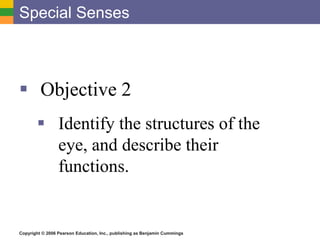More Related Content
More from Anthony DePhillips (20)
Eye
- 1. Copyright © 2006 Pearson Education, Inc., publishing as Benjamin Cummings
Special Senses
Objective 2
Identify the structures of the
eye, and describe their
functions.
- 2. Copyright © 2006 Pearson Education, Inc., publishing as Benjamin Cummings
The Eye and Vision
70 percent of all sensory receptors are in the
eyes
Each eye has over a million nerve fibers
Protection for the eye
Most of the eye is enclosed in a bony orbit
A cushion of fat surrounds most of the eye
- 3. Copyright © 2006 Pearson Education, Inc., publishing as Benjamin Cummings
Protective Structures of the Eye
Eyelids
Eyelashes
Figure 8.1b
- 4. Copyright © 2006 Pearson Education, Inc., publishing as Benjamin Cummings
Accessory Structures of the Eye
Ciliary glands –
modified
sweat glands
between the
eyelashes
Figure 8.1b
- 5. Copyright © 2006 Pearson Education, Inc., publishing as Benjamin Cummings
Accessory Structures of the Eye
Conjunctiva
Membrane that lines the eyelids
Connects to the surface of the eye
Secretes mucus to lubricate the eye
- 6. Copyright © 2006 Pearson Education, Inc., publishing as Benjamin Cummings
Accessory Structures of the Eye
Lacrimal apparatus –
Secrete Tears
Lacrimal gland –
produces lacrimal
fluid
Lacrimal canals –
drains lacrimal
fluid from eyes
Figure 8.1a
- 7. Copyright © 2006 Pearson Education, Inc., publishing as Benjamin Cummings
Function of the Lacrimal Apparatus
Properties of lacrimal fluid
Dilute salt solution (tears)
Contains antibodies and lysozyme
Protects, moistens, and lubricates the eye
Empties into the nasal cavity
- 8. Copyright © 2006 Pearson Education, Inc., publishing as Benjamin Cummings
Extrinsic Eye Muscles
Muscles attach to the outer surface of the eye
Produce eye movements
Figure 8.2
- 9. Copyright © 2006 Pearson Education, Inc., publishing as Benjamin Cummings
Structure of the Eye
The wall is composed of three tunics
Fibrous tunic –
outside layer
Choroid –
middle
layer
Sensory
tunic –
inside
layer
Figure 8.3a
- 10. Copyright © 2006 Pearson Education, Inc., publishing as Benjamin Cummings
The Fibrous Tunic
Sclera
White connective tissue layer
Seen anteriorly as the “white of the eye”
Cornea
Transparent, central anterior portion
Allows for light to pass through
Repairs itself easily
The only human tissue that can be transplanted
without fear of rejection
- 11. Copyright © 2006 Pearson Education, Inc., publishing as Benjamin Cummings
Choroid Layer
Blood-rich nutritive tunic
Pigment prevents light from scattering
Modified interiorly into two structures
Cilliary body – smooth muscle that
changes the shape of the lens
Iris – contracts/expands to let light in
Pigmented layer that gives eye color
Pupil – rounded opening in the iris
- 12. Copyright © 2006 Pearson Education, Inc., publishing as Benjamin Cummings
Sensory Tunic (Retina)
Contains receptor cells (photoreceptors)
Rods
Cones
Signals leave the retina toward the brain
through the optic nerve in the back of the eye
- 13. Copyright © 2006 Pearson Education, Inc., publishing as Benjamin Cummings
Special Senses
Objective 3
Compare and contrast the
structure and functions of
rods and cones.
- 14. Copyright © 2006 Pearson Education, Inc., publishing as Benjamin Cummings
Neurons of the Retina and Vision
Rods
Most are found towards the edges of the
retina
Allow dim light vision and peripheral
vision
Perception is all in gray tones
- 15. Copyright © 2006 Pearson Education, Inc., publishing as Benjamin Cummings
Neurons of the Retina and Vision
Cones
Allow for detailed color vision
Densest in the center of the retina
Fovea centralis – area of the retina with
only cones
No photoreceptor cells are at the optic disk,
or blind spot
- 16. Copyright © 2006 Pearson Education, Inc., publishing as Benjamin Cummings
Neurons of the Retina
Figure 8.4
- 17. Copyright © 2006 Pearson Education, Inc., publishing as Benjamin Cummings
Cone Sensitivity
There are three
types of cones
Different cones are
sensitive to different
wavelengths
Color blindness is
the result of lack of
one cone type
Figure 8.6
- 18. Copyright © 2006 Pearson Education, Inc., publishing as Benjamin Cummings
Special Senses
Objective 4
Trace the pathway of light
through the retina.
- 19. Copyright © 2006 Pearson Education, Inc., publishing as Benjamin Cummings
Lens
Biconvex crystal-like structure
Held in place by a suspensory ligament
attached to the ciliary body
Figure 8.3a
- 20. Copyright © 2006 Pearson Education, Inc., publishing as Benjamin Cummings
Internal Eye Chamber Fluids
Aqueous humor
Watery fluid found in chamber between
the lens and cornea
Similar to blood plasma
Helps maintain intraocular pressure
Provides nutrients for the lens and cornea
Reabsorbed into venous blood through the
canal of Schlemm
- 21. Copyright © 2006 Pearson Education, Inc., publishing as Benjamin Cummings
Internal Eye Chamber Fluids
Vitreous humor
Gel-like substance behind the lens
Keeps the eye from collapsing
Lasts a lifetime and is not replaced
- 22. Copyright © 2006 Pearson Education, Inc., publishing as Benjamin Cummings
Lens Accommodation
Light must be focused
to a point on the
retina for optimal
vision
The eye is set for
distance vision
(over 20 ft away)
The lens must change
shape to focus for
closer objects
Figure 8.9
- 23. Copyright © 2006 Pearson Education, Inc., publishing as Benjamin Cummings
Images Formed on the Retina
Figure 8.10
- 24. Copyright © 2006 Pearson Education, Inc., publishing as Benjamin Cummings
Visual Pathway
1. Photoreceptors of the
retina
2. Optic nerve
3. Optic nerve crosses at
the optic chiasma
4. Optic tracts
5. Thalamus (axons form
optic radiation)
6. Visual cortex of the
occipital lobe
Figure 8.11
- 25. Copyright © 2006 Pearson Education, Inc., publishing as Benjamin Cummings
Eye Reflexes
Internal muscles are controlled by the autonomic
nervous system
Bright light causes pupils to constrict through
action of radial and ciliary muscles
Viewing close objects causes accommodation
External muscles control eye movement to follow
objects
Viewing close objects causes convergence (eyes
moving medially)
